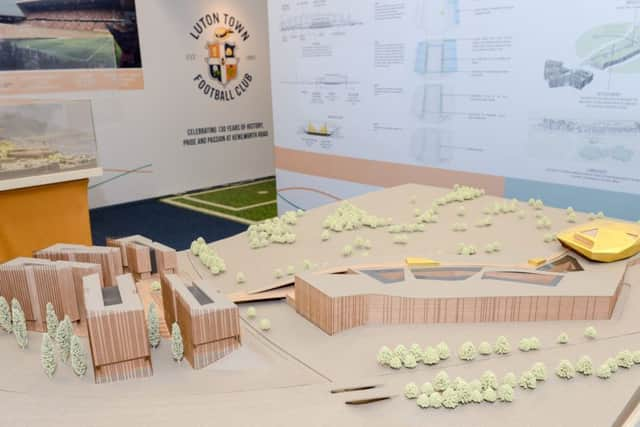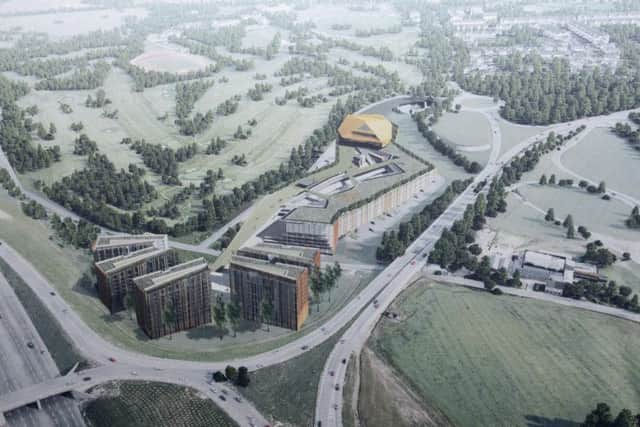In-depth look at the Luton Council report that recommends approval of Hatters’ Newlands Park scheme
and live on Freeview channel 276
A location for Kenilworth Road’s successor always appeared destined to be somewhere close to the M1, with out-of-town grounds seen as the desirable solution.
But there are pros and cons to these modern stadiums, which have come to be viewed as rather remote and liable to increase traffic.
Advertisement
Hide AdAdvertisement
Hide AdSo 2020 Developments, the company behind the football club, spread its net far and wide in the hunt for a suitable parcel of land in the town.


Their search ended at Power Court, where their vision for football in Bedfordshire for the 21st Century was approved by Luton planners in January.
Now for the second stage of that dream, with all eyes focused on the enabling development, Newlands Park, and the potential for a new gateway to Luton.
Hugging the M1 by junction ten, the land itself appears to lack specific appeal, but it is within a stone’s throw of the Luton Hoo estate and Stockwood Park.
Advertisement
Hide AdAdvertisement
Hide AdThe Newlands Park site has been allocated for mixed-use development since the mid-1990s, according to a report to the borough council’s development control committee released earlier today [click here].


“This allocation originated when the council identified the site as its preferred location for a new football stadium for the club,” says the report.
“An outline application was made for a multi-use indoor stadium and hotel, leisure and education facilities with car parking and park and ride facilities (known as the Kohlerdome Scheme) in April 1995.
“And an application for a multi-use stadium, arena and hotel, retail and petrol filling station facilities, also with car parking and a park and ride facility, was submitted in September 1995.
Advertisement
Hide AdAdvertisement
Hide Ad“Both of these applications were called in by the Secretary of State and were refused planning permission on highway grounds in August 1998.”
Now the project adopts a different theme with:
office development of up to 42,000sqm of floorspace;
up to 13,000sqm of hotel (maximum 350 beds);
up to 16,000sqm of leisure floorspace;
up to 37,000sqm of comparison retail floorspace;
up to 300sqm of convenience retail floorspace;
up to 8,500sqm of food and drink floorspace;
up to 8,500sqm of retail/leisure servicing and ancillary floorspace;
between 3,000 – 3,600 car parking spaces;
and associated access, highways, utilities, public realm, landscaping and associated ancillary works and structures.
The report to borough councillors says: “The application seeks outline planning permission for a mixed-use development.
Advertisement
Hide AdAdvertisement
Hide Ad“It will consist of a leisure hub, along with retail, entertainment, hotel, conference centre and offices, as well as public open space.”
The economic benefits included the equivalent of around 9,000 full-time jobs, according to the applicant.
Newlands Park will contribute a gross value of around of £235m annually to the Luton economy between 2020 and 2040, say 2020 Developments.
“It will help claw back retail expenditure leaking to other centres to help Luton compete with the significant new retail development at Houghton Regis, Milton Keynes and Watford,” adds 2020.
Advertisement
Hide AdAdvertisement
Hide AdAnd it will create that gateway into Luton, close to London Luton Airport, the M1 and Luton itself, helping “support the wider regeneration of the area”.
But not everyone is happy at this prospect, not least property and assets firm Capital and Regional, the owners of The Mall in Luton town centre.
The company objects to the Newlands Park scheme, claiming the site should be used for a football stadium, and that the planned use will detract from and take business away from its shopping centre.
It also claims that the Power Court site could accommodate several aspects the enabling development project.
The firm is not alone in protesting against Newlands Park.
Advertisement
Hide AdAdvertisement
Hide AdMilton Keynes Council “objects to the proposal on the basis that the applicant’s assessment has failed to take into account the latest available data from a MKC retail capacity and leisure study”.
And the concept “may be underestimating the impact of the proposal on shopping centres outside Luton borough and the centre of Milton Keynes”.
Houghton Regis Development Consortium also objects, saying “the development is contrary to the principles of the development plan”.
Central Bedfordshire Council says the application “does not show an acceptable relationship with Luton Hoo or the listed buildings at Slip End.
Advertisement
Hide AdAdvertisement
Hide Ad“Further information is required as part of the Environmental Statement in order to conclude on the proposal in this regard.
“And appropriate measures should be put in place as part of any planning permission to avoid any uncontrolled overspill parking within Central Bedfordshire.”
There are other concerns to oversome as well, not least those of Historic England and the archaeological issues.
On the latter, the report says: “There was no objection in principle.
Advertisement
Hide AdAdvertisement
Hide Ad“But concern was expressed that there was not enough information on the impact of the development proposals on the archaeological resource to provide advice on how best to mitigate that impact of the development.
“The application has failed to show that appropriate analysis of the impact of the development on heritage assets (specifically the potential Palaeolithic resource) has been undertaken and has not set out how any impacts may be mitigated.”
Meanwhile, Historic England “continues to object to the application on heritage grounds, as it would result in a severe degree of harm to Luton Hoo”.
Many months have been spent examining the plans in detail and resulting in some changes to the local planning layout.
Advertisement
Hide AdAdvertisement
Hide AdThese include: “The deletion of the provision of a football stadium and supporting enabling ancillary uses at Junction 10a, the retention of B1 business park and the park and ride allocation.
“There is also new policy which deals with the review of the Local Plan, which specifically refers to the relocation of Luton Town Football Club and uses and policies relating to the strategic allocation at land south of Stockwood Park.”
“The site is a prime gateway into Luton which is identified as a strategic allocation in the Local Plan.
“It is a site which has been allocated since 1997 and hasn’t come forward for development,” explains the report.
“Of particular note is the quantum of retail development.
Advertisement
Hide AdAdvertisement
Hide Ad“Significant weight should be given to the impact of the proposed level of retail on the vitality and viability of existing town centres within Luton and neighbouring authorities.
“This should consider not only current provision, but also planned investment and regeneration objectives including the key regeneration area of Luton town centre between the railway station and The Mall.
“The sequential test will need to be carefully considered to demonstrate that the proposal meets the requirements set out in the National Planning Policy Framework.
“In summary, the proposals on land south of Stockwood Park raise some significant concerns particularly focusing on potential adverse town centre impacts.
Advertisement
Hide AdAdvertisement
Hide Ad“These will have to be weighed carefully against the benefits of bringing forward a site that could attract investment and create a prestigious southern gateway into Luton.”
The plans have been recommended for approval and will be considered by the borough council’s development control committee on Monday, March 11.